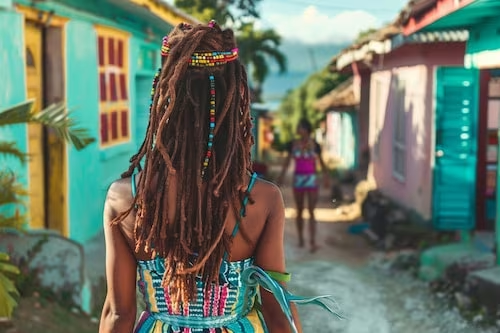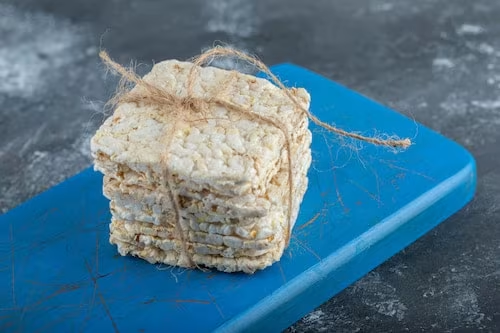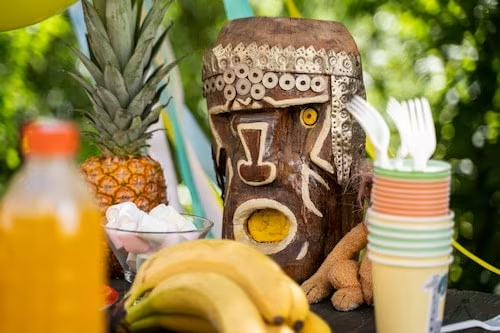Taino culture in the Dominican Republic: history, symbols & living legacy
Taino culture in the Dominican Republic: history, symbols & living legacy
The Dominican Republic is a country rich in history and traditions, marked by the influence of different civilizations. Before the arrival of Europeans in 1492, the island of Hispaniola (which today includes the Dominican Republic and Haiti) was inhabited by the taíno people, an Amerindian people whose traditions are still present today.
From language and spiritual beliefs to crafts and cuisine, Taíno culture continues to play an important role in the daily lives of Dominicans. Travel back in time and discover how this ancestral indigenous and african heritage is passed down from generation to generation.

Who were the taíno people? A nation with deep roots
The taíno people were a group of Arawaks, Amerindians who migrated from South America to the Caribbean. When Christopher Columbus arrived in 1492, it is estimated that between 500,000 and 1 million Tainos lived on the island of Hispaniola.
This peaceful people were organized into chiefdoms led by chiefs and derived their resources primarily from agriculture, fishing, and gathering. Unfortunately, colonization led to the near extinction of the Taíno people, who fell victim to disease, slavery, and inhumane treatment.
Their religion centered on zemis—spiritual beings or gods that represented natural forces.
The Taíno language left a lasting mark: words like hamaca (hammock), barbacoa (barbecue), and huracán (hurricane) are still used today.
However, the taíno culture heritage, religious and language education has endured and continues to influence Dominican identity today.
The influence of the Taino on the Dominican Republic
Many words of Taino origin have survived over the centuries and continue to be used in the everyday language of Dominicans. Some of these words have even been incorporated into other languages, including Spanish and English.
Here are some words of Taíno culture origin that are still in use:
✅ Bohío: refers to a hut or house built of wood and palm leaves, typical of the Caribbean style.
✅ Hamacá (hammock): a cloth or net hammock used by the Taino for sleeping and resting.
✅ Barbacoa: a cooking method that involves grilling meat over an open fire, a technique that has survived through the ages.
✅ Huracán: a term inspired by Taino beliefs to describe tropical and cyclonic storms.
Maíz (corn) and yuca (cassava): two staples of the Taino diet that are still widely consumed today.
Anecdote: Many place names in the Dominican Republic, such as Jarabacoa, Cotuí or Haina, come from the Taíno language.
Taino culture in modern dominican identity
Despite colonization and the near-eradication of the Taíno population, Taino culture and taíno believed persist in many facets of daily life:
✨ 1. Dominican Republic Taino symbols and art
Petroglyphs and pictograms can be seen at:
Pomier Caves (San Cristóbal): Over 500 ancient carvings
Los Haitises National Park: Accessible by boat, filled with rock art and sacred caves
Carved Taíno symbols like the coqui, sun, and spiral motifs are still found in local jewelry, wood carvings, and home décor.
✨ 2. Taíno women and gender roles
The Taíno women played key roles in agriculture, textile weaving, and even politics—some cacicas (female chiefs) led communities. Their spiritual power as healers lives on in Dominican folk medicine.
Taino influence on Dominican cuisine
Dominican cuisine is deeply rooted in Taino traditions, enriched over time by African and European influences. Many Dominican dishes are directly inspired by Amerindian cuisine, using basic ingredients such as corn, yuca, sweet potatoes and various tropical fruits.
Taino food are still eaten today:
🥘 Casabe: a flat bread made from manioc flour, essential in Taino culture and still appreciated in the Dominican Republic.

🍵 Chacá: Chacá is a sweet corn porridge, inherited from the Taino people and still enjoyed today.
🥩 Guanime: a tamale made with cornmeal and cooked in banana leaves.
🥑 Tropical fruits: The cultivation of guava and pineapple has its origins in the agricultural traditions of the Taino people.

Taino craftsmanship: an enduring heritage
Taino craftsmanship has had a profound influence on Dominican culture, especially through pottery, stone carvings, and sculpted symbols.
Taino artistic expression is still very much alive.
Pictograms and petroglyphs: Numerous archaeological sites in the Dominican Republic bear witness to the artistic wealth of the Taino people. The Pomier Cave near San Cristóbal, for example, contains centuries-old rock paintings.
Sculptures in stone and wood: Taino carved cemis, small statues representing gods or ancestors.
Ancestors.
Larimar and amber jewelry: Although technology has evolved, the origins of semi-precious jewelry remain rooted in Taino craftsmanship.
Spirituality and Taíno religion
The Taíno religion revered natural elements like the moon, sun, rain, and wind. Rituals were held in sacred spaces such as caves, mountains, and ceibas (sacred trees).
Vestiges of these beliefs persist:
Traditional herbal medicine and spiritual cleansings
Veneration of nature in folk Catholicism and local festivals
Syncretic beliefs that honor both Catholic saints and ancient spirits
The Taino people had a rich spirituality centered on the cult of Semis (God) and the forces of nature. Although colonization introduced Catholicism, certain Taino beliefs and practices persisted in various forms.
Spiritual Relics in Dominican Culture
Healing methods and natural medicine: The use of medicinal plants and shamanic rituals originate from Taino traditions.
Respect for the natural elements: water, mountains and caves are still considered important spiritual places.
Traditional festivals and ritual dances: Some celebrations, such as the Dominican Carnival, include elements inspired by Taino rituals.
Where to experience Taino culture in the Dominican Republic
To immerse yourself in the Taino heritage, here are some places not to be missed:
🏛️ The Dominican Museum (Santo Domingo) - Discover the Taino people through exhibitions of ancient artifacts.
🌿 Los Haitises National Park - A magnificent site with caves decorated with rock art.
Grotte Pomier - A true archaeological treasure trove where you can admire Taino paintings.
🏝️ Saona Island - Archaeological finds attest to the presence of the Taino people on this idyllic island.
Taino people today: Rediscovering identity
So, does Taino culture still exist?
Yes. While genetically mixed, many Dominicans proudly reclaim Taíno identity today. Cultural groups, museums, and artists celebrate this heritage with:
Revivals of Taíno language (reconstructed for educational use)
Dance performances at local festivals
Modern artisans crafting Taino-style jewelry and crafts
➤ What was the culture of the Taínos?
Taíno culture was rich in symbolism, centered on nature, zemis, storytelling, and communal living. They valued harmony with the environment and had a sophisticated social system.
➤ Does Taino culture still exist?
Yes, elements survive in Dominican language, cuisine, rituals, and art. A growing movement proudly embraces Taino identity and heritage.
➤ What race is Taino?
The Taínos were indigenous Caribbean people, part of the Arawakan ethnolinguistic group.
➤ Do Dominicans have Taino blood?
Genetic studies show many Dominicans have partial Taíno ancestry, blended with African and European roots due to colonial history.
➤ Are Taínos considered Black?
The Taínos were not of African descent, but Dominican identity today often includes Afro-Taíno heritage due to centuries of cultural fusion.
➤ What language did Dominican Taínos speak?
The Taíno language, part of the Arawakan family. While extinct, some words and phrases are preserved and being reintroduced culturally.
Travel tip from Jumbo Car: Explore Taino history at your own pace
Rent a vehicle with Jumbo Car Dominican Republic and embark on your own cultural road trip. From Santo Domingo's museums to the sacred caves of Samaná, discover the living legacy of the Taíno people with full freedom and comfort.
Taino culture continues to influence the cuisine, art, language and traditions of the Dominican Republic. Although colonization had a profound effect on the Taino people, their heritage is still present in the local culture.
To explore these hidden treasures, there's nothing like the freedom of adventure! Rent a car from Jumbo Car and discover the historic Taino ruins in the heart of nature and history.
Book your car today and immerse yourself in the history of the Tainos!